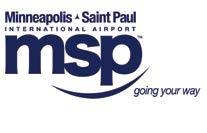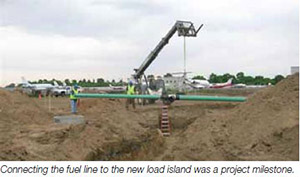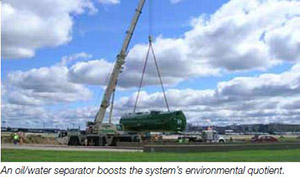Minneapolis-St. Paul Int'l Eyes Future With New Fueling Facility
 When an airport constructs a new fuel farm, it's generally because the old one is hampered by outdated technology or has reached the end of its useful life. That wasn't the case at Minneapolis-St. Paul International Airport (MSP). Its late-1990s Terminal 2-Humphrey Tank Farm was still pumping jet-A and mogas (automotive fuel) effectively, but the facility needed to be removed to make room for future airside and landside expansion.
When an airport constructs a new fuel farm, it's generally because the old one is hampered by outdated technology or has reached the end of its useful life. That wasn't the case at Minneapolis-St. Paul International Airport (MSP). Its late-1990s Terminal 2-Humphrey Tank Farm was still pumping jet-A and mogas (automotive fuel) effectively, but the facility needed to be removed to make room for future airside and landside expansion.
After about seven months of active construction, the $6.5 million project is nearly complete. In addition to providing jet-A and mogas like its predecessor, the new facility will also pump diesel fuel.
 factsfigures factsfiguresProject: Fueling Facility Location: Minneapolis-St. Paul Int'l Airport Cost: $6.5 million Start of Construction: April 2012 Expected Completion: November 2012 Airfield Engineer: TKDA Fuel Farm Construction: Seneca Companies Of Note: Crews had to trench under an airport roadway to link the new facility to the existing jet-A pipeline |
Anticipated traffic growth spurred the project, relates Patrick Mosites, airside project manager for the Metropolitan Airports Commission. MSP currently serves approximately 33 million passengers annually, but that number is projected to rise to 56 million by 2030. The airport needs to prepare now to meet the increased demand, Mosites explains.
"We had to create a new fuel island at a new location in order to tear down this facility and make room for future projects," he explains. Plans on the books include up to 17 additional gates, a rental car center and new parking facilities.
"The existing (fuel) facility is being demolished and brought back to natural grade," reports Rowdy O'Grady, project manager for fuel farm contractor Seneca Companies. "It will be as if the existing facility was never there."
While crews finish the new fuel facility, the airport is also completing environmental reviews for the proposed $2 billion terminal expansion. "We are going to expand Terminal 2 to the north and the south based on demand," Mosites explains. Expansion of the north apron is scheduled to begin immediately if the assessment is approved and the airport receives FAA funding.
The terminal building expansion, which will be funded with passenger facility charges, will wait until demand requires it, he adds.
Project Scope
MSP's $6.5 million fueling facility project affected five areas, named A through E. The new fueling facility, in Area B, is expected to come online in November, reports Lisa Coffelt, of Seneca's Aviation Fueling Division.
The project began, however, with a challenging search for a new location. "The selected site was the closest available space that didn't interfere with future expansion and didn't require tenants to cross active taxiways for fuel," explains Chad Gunderson, project manager/engineer for airfield engineer TKDA.
The site also accommodates larger tanker trucks and vehicles than the old farm. "There's just a little more space to work with and the facility's general alignment allows for larger vehicles," explains Gunderson.
The new facility is engineered for bulk loading jet-A fuel at 600 gallons per minute and mogas at 150. Its diesel and mogas stations are designed to fuel ground service equipment at a rate of 15 to 20 gallons per minute from two 12,000-gallon tanks.
 "The FAA was very happy with what we came up with,"reports TKDA Vice President John Ahern.
"The FAA was very happy with what we came up with,"reports TKDA Vice President John Ahern.
The project's environmental elements include an oil-water separator to process runoff via a contained storm drain with a 25,000-gallon tank. The separators will capture fuel spills then separate clean water from the oil/slime on the surface.
The fuel tanks themselves are double walled and contain monitors to detect leakage. In addition, an emergency fuel shut-off system can take the entire fueling island offline immediately should leakage occur.
"At MSP we are very protective of the environment because we are right next to the Minnesota River," Mosites explains. "Bells and whistles were put in place to prevent anything from reaching the river."
The facility's bulk loadouts contain an electronic metering system that monitors flow rates for jet-A and mogas. Working in conjunction with a card lock system that requires drivers to enter a code to access the fueling system, it allows the main terminal control facility to monitor how much fuel each employee pumps from the system.
Other Elements
Area A, across the airport, was revamped with a new 12,000-gallon split tank for diesel and mogas. Area C, where the old facility was located, received two new valve pits that connect to existing jet-A fuel lines. Crews recently began demolishing the site's 500,000-gallon fuel tanks, fuel loading facility and communications building. Although the airport doesn't expect to encounter impacted soils, TKDA and Seneca are prepared to address such issues if needed, notes O'Grady.
Area D will eventually tie into the airport's primary 7 million-gallon jet-A line. Plans for Area E include construction of a concrete containment area, drainage and electric preparation for a future glycol system. Such improvements will allow Southwest Airlines to install glycol storage tanks and dispensing equipment close to Terminal 2, notes Mosites.
O'Grady expects the main facility in Area B to begin commissioning and fuel flushing in late September. The next phase will include pouring concrete, setting equipment and completing the tie-ins.
Special Considerations
Extensive planning and careful scheduling are critical to successfully construct a new fueling facility at an operational airport, says O'Grady.
Connecting the new rectangular-shaped facility to existing infrastructure presented a few extra hurdles. "Trenching under the existing roadway, an internal transit artery between Terminal One and Terminal Two, was necessary to connect the new pipeline to the existing jet-A pipeline," he explains.
Seneca staged work to allow the airport to use the road's shoulder and keep two lanes of traffic open as crews installed single-wall, steel-welded jet-A piping. In doing so, the company surpassed the minimum requirement for at least one open lane set by the airports commission.
Connecting the new fueling system to the jet-A line, which provides fuel for all Terminal 2 aircraft, was another challenge. Crews had pipeline tie-ins in areas B and C. Further complicating matters, the existing fuel island couldn't be taken out of service until the new one was fully operational.
Working with the airports commission and TKDA, Seneca scheduled the tie-ins for late September, from a Friday morning to Sunday night. The airport has enough fueling trucks to handle weekend demand, which tends to be lighter than weekday demand, notes O'Grady.
"Enough fuel will be available until Sunday evening," he explains. "But we have to have (the new facility) up and running by that time in order to continue normal fueling operations at the terminal."
Ahern expects the tie-ins to run smoothly. "It's night work and you have to know what you're doing," he comments. "But if you have the right people in place, it's not an issue."
If a problem does arise during the tie-ins, the new facility's looped system can be closed off. "While the airport wouldn't have the type of pressure needed to fuel aircraft at the rate they would like, they'd still be able to fuel aircraft and remain operational," Ahern assures.
An Eye on Security
With all five areas of the project located inside MSP's secured identification display area, work crews had to follow special security procedures. All Seneca employees were badged, and every subcontractor had to have at least one badged foreman onsite at all times. "That was a big push, because it may take up to four weeks to complete the process," says O'Grady, noting that prompt badging was key to keeping production on schedule.
TKDA and the airports commission set up a security checkpoint at a temporary gate in the security fence near the main construction site, where officials screened every person and vehicle entering the area.
Ahern contrasts MSP's measures with years ago, when airport projects included an open construction gate with one TSA officer on duty. "A single person standing there isn't going to stop someone from driving through," he relates. "We installed resettable crash barriers so trucks can't drive through until they have been checked and the security guard presses a switch dropping the crash barrier to allow them through."
Increased security required extra planning on Seneca's part, acknowledges O'Grady. "It can take security personnel five to 10 minutes to search each vehicle," he explains, noting the importance of maintaining efficient traffic into and out of the secured area.
In the Loop
O'Grady attributes the project's hiccup-free progress to solid communication among team members. Seneca and TKDA met with subcontractors every Tuesday to set the next two weeks' construction schedule and strategize about safety issues.
TKDA also worked to keep tenants in the loop. That way, tenants were aware of the challenges crews faced, and the crews learned ways to accommodate the tenants, Ahern explains.
The end result, he reports, is a fueling facility he is confident will serve MSP and its tenants well for many years to come.
2022 Charlotte Douglas International Airport Report of Achievement
 Giving back to the community is central to what Charlotte Douglas International Airport and its operator, the City of Charlotte Aviation Department, is about, and last year was no different.
Giving back to the community is central to what Charlotte Douglas International Airport and its operator, the City of Charlotte Aviation Department, is about, and last year was no different.
Throughout 2022, while recovering from the COVID-19 pandemic, we continued our efforts to have a positive impact on the Charlotte community. Of particular note, we spent the year sharing stories of how Connections Don't Just Happen at the Terminal - from creating homeownership and employment opportunities to supporting economic growth through small-business development and offering outreach programs to help residents understand the Airport better.
This whitepaper highlights the construction projects, initiatives, programs and events that validate Charlotte Douglas as a premier airport.
Download the whitepaper: 2022 Charlotte Douglas International Airport Report of Achievement.








